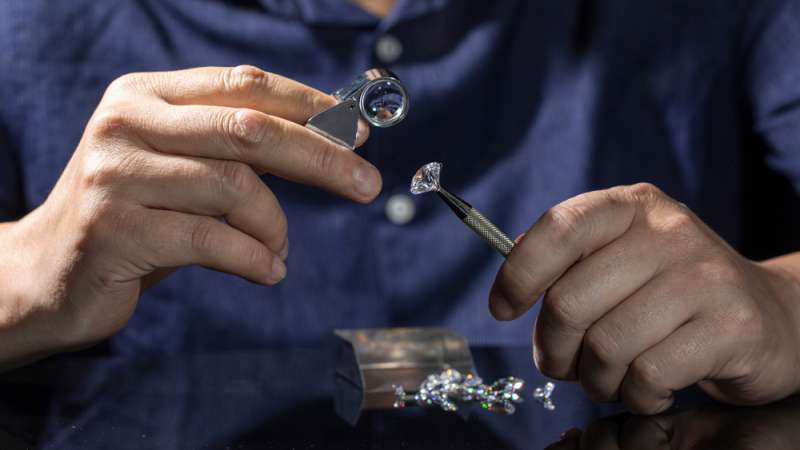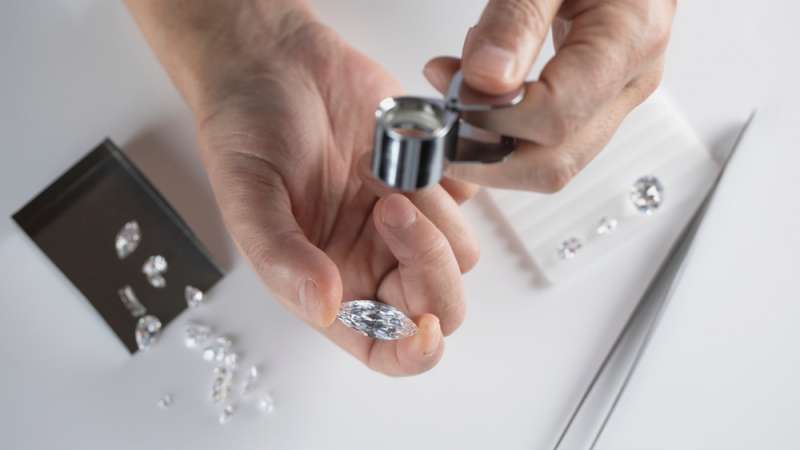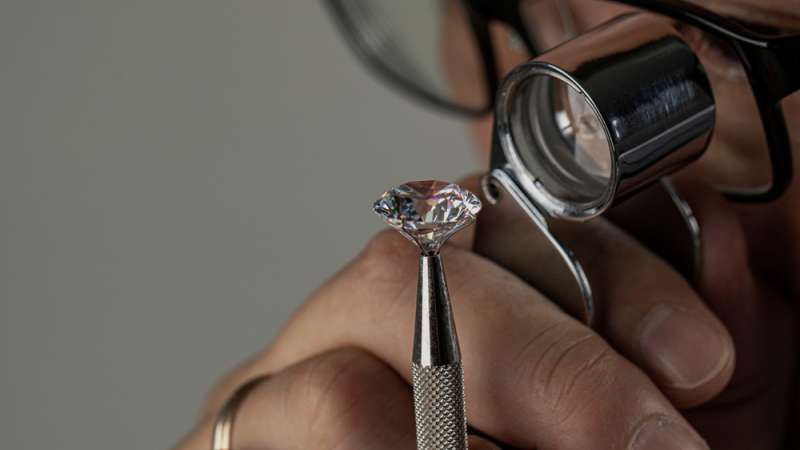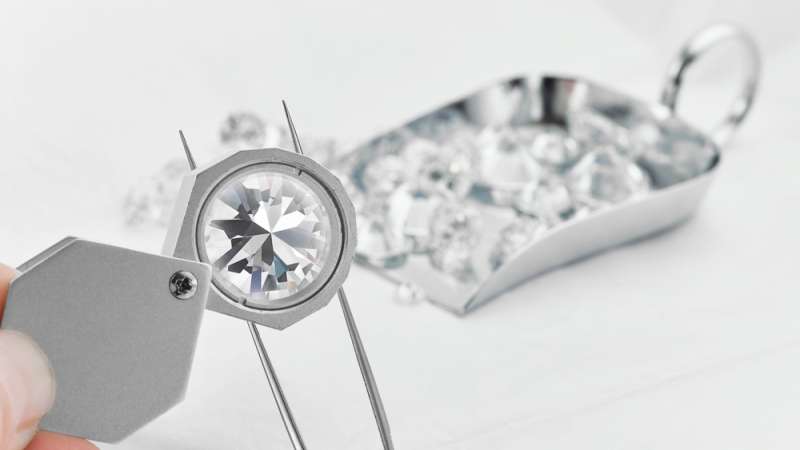Similar to humans, diamonds possess natural “birthmarks” that develop as they form deep within the Earth. These birthmarks, known as “clarity features” or inclusions, are small imperfections and characteristics that can be observed by a professional grader under 10x magnification.
Inclusions serve multiple purposes in assessing a diamond’s quality. They not only aid in distinguishing between natural and synthetic stones but also contribute to evaluating a diamond’s overall quality. The visibility of these clarity features to the naked eye depends on their size, quantity, placement, tone, and color. This is why finding a truly flawless diamond is an incredibly rare occurrence.
Now, what if it were possible to remove these inclusions? Would a diamond become more beautiful and valuable? In this article, we will explore the nature of inclusions, discuss different types of inclusions, and examine whether they are necessarily detrimental to a diamond’s value. Additionally, we will address the burning question on everyone’s mind: Can inclusions be eliminated from a diamond?
Let’s delve into the subject and find out!
DESIGN YOUR OWN ENGAGEMENT RING: START WITH A SETTING OR START WITH A DIAMOND. IT’S REALLY UP TO YOU!

Can You Remove Inclusions From a Diamond?
The simple answer to the question is:
Yes, it is possible to remove inclusions from a diamond. There are various techniques available that can significantly improve the clarity and overall appearance of a diamond by eliminating imperfections.
However, it’s important to note that depending on the type and size of the inclusions, these treatments may impact the diamond’s weight and shape.
Methods to Enhance Clarity (Remove Inclusions)
Here are some treatments used to remove inclusions from diamonds:
- Laser Drilling
Diamond experts can use lasers to remove or lighten a dark inclusion by creating a small hole in its location. The laser may cause the inclusion to burn, or the diamond can be treated with bleach or acid to further enhance its brightness.
While the initial inclusion becomes less visible, laser-drilled diamonds will have a small tunnel from the surface to the inclusion. Despite this tunnel, the improved clarity of the diamond should positively impact its rating.
The tunnel created by laser drilling is incredibly small (around 20-25 microns in diameter) and has no effect on the diamond’s weight. It is thinner than a strand of hair.
Laser-drilled diamonds may be more prone to brittleness due to the alteration of the crystal structure caused by the laser. Additionally, dirt can accumulate in the tunnel, making it more noticeable.
It’s important to note that the drill hole cannot be removed, as laser drilling is considered a permanent treatment. However, the diamond may undergo fracture filling after drilling.
- Fracture Filling
One common treatment used to enhance diamond clarity is injecting molten leaded glass-like material into fractures within the diamond. Fracture filling effectively conceals surface-reaching fractures.
This treatment can also be used to repair diamonds that have been accidentally broken.
With proper care, the filling can last for years, although it may be damaged during routine jewelry repairs or frequent cleanings with steam, acid, or ultrasonic methods.
If the filler melts and spills out, it may be possible to reapply it. However, once the filler has turned dark, it cannot be restored to its original color. Fracture filling can improve a diamond’s appearance but may significantly lower its color grade.
- Recutting
Recutting a diamond is another approach to enhance its clarity. This involves removing material from all sides of the stone, eliminating some of the impurities in the process.
The drawback of this technique is evident: it reduces the carat weight of the diamond, resulting in a smaller and less expensive stone. This method is only effective if the inclusions are primarily located near the surface of the diamond; if they are closer to the center, they cannot be cut out.
Please note that the decision to undergo any of these treatments should be made carefully and with the guidance of a reputable jeweler or diamond expert.

What Are Diamond Inclusions?
The term “inclusion” is sometimes misunderstood to primarily refer to the black marks found in diamonds, which are actually crystals of minerals within the diamond. However, there are various types of inclusions that can occur in a diamond, and not all of them are naturally formed.
A perfect diamond consists solely of carbon organized in a crystal lattice without any other minerals. Anything confined within the diamond is considered an inclusion. These inclusions can include smaller diamonds, gem crystals like sapphire and garnet, as well as other elements and minerals.
Inclusions are essentially disruptions or cracks in the carbon lattice, such as feathers, twinning wisps, and graining. Inclusions also encompass any characteristics that can be seen at 10x magnification by a qualified grader. It’s worth mentioning elements like chips and naturals, which are surface flaws rather than inclusions within the diamond.
When a diamond is evaluated for clarity, the quantity, size, type, and location of these inclusions and blemishes are analyzed, along with their impact on the overall appearance of the stone. It’s important to note that no diamond is 100% pure, but the closer it gets to purity, the clearer it appears.
The GIA Diamond Clarity Scale consists of six categories: Flawless (FL), Internally Flawless (IF), Very Very Slightly Included (VVS1 & VVS2), Very Slightly Included (VS1 & VS2), Slightly Included (SI1 & SI2), and Included (I1, I2, & I3). The top five clarity grades show no significant difference in performance or aesthetics, but there can be substantial price differences due to rarity.
Higher clarity grades are more expensive because diamonds with fewer inclusions are rarer in nature. While most people may not be able to distinguish the difference in appearance, these rarer gems command higher prices. Therefore, consumers seeking the best value can opt for VS and SI grades, which offer equally stunning diamonds at a fraction of the cost compared to theoretically purer grades.

How Gemologists Classify Inclusions In Diamonds
Renowned third-party diamond certifying labs like the GIA and AGSL follow a precise protocol when identifying and evaluating inclusions. The clarity grade of a diamond can be influenced by factors such as the size, type, and location of the inclusion.
These gem laboratories adhere to four guidelines:
- Size: Gemologists start by determining the size of the inclusion. Larger diamond inclusions result in a lower clarity rating.
- Quantity: The number of visible inclusions on a diamond is taken into account. A higher quantity of inclusions, especially on the table of the diamond, can lead to a lower clarity grade.
- Location: The positioning of the inclusions within the diamond is considered. Inclusions located towards the bottom or pavilion of the diamond have a lower impact on the clarity grade since diamonds are assessed from top to bottom.
- Internal vs. External: Gemologists evaluate whether the inclusions are internal or external. External inclusions, such as those on the table, have the potential to lower the clarity grade. However, diamonds can still receive an Internally Flawless rating even if they have no internal inclusions.
By following these guidelines, gemologists can accurately assess the impact of inclusions on a diamond’s clarity grade and provide an objective evaluation of its quality.

Diamond Inclusions Types
As mentioned earlier, not all inclusions are the same, and understanding them can help you make an informed decision when purchasing a diamond.
The most common type of inclusion is pinpoint inclusions, which are tiny black spots resembling blackheads on the skin that appear on the diamond’s table.
Feather inclusions are the second most common type and should be a cause for concern. They are small internal fissures that, if they extend from top to bottom, can compromise the diamond’s durability.
Diamond cavities are the rarest type of inclusion and are similar to tooth cavities, resulting in tiny holes within the diamond. It is advisable to avoid stones with cavities as they are typically categorized as “industrial grade” and not suitable for jewelry.
Now let’s explore different types of diamond inclusions:
Laser Drill Hole:
Permanent laser-drilled holes in diamonds are graded by the GIA. If the drill hole is difficult to see on the surface, it will be noted as “Internal laser drilling is present” in the comments section. Laser drilling is irreversible and can significantly impact the diamond’s price.
Crystal:
Crystal inclusions come in various shapes and colors, with the color being determined by the mineral trapped within the diamond. Common crystal colors include white (tiny diamond crystals), black (carbon or graphite), red (garnets), and occasionally green (peridot pieces trapped in the diamond). In most cases, crystal inclusions in eye-clean diamonds pose no significant durability threat.
Needle:
Needles are thin, elongated crystals that develop under extreme pressure, appearing as small rods under 10x magnification. While typically white or translucent and often not visible to the naked eye, clustered needles can affect the diamond’s purity and value.
Pinpoint:
Pinpoints are microscopic white or black crystals trapped within the diamond, appearing as tiny dots under magnification. Individual pinpoints usually do not impact the diamond’s purity significantly, but when three or more are joined, they form a cloud that can affect the diamond’s clarity based on the number and color of pinpoints.
Cloud:
A cloud is a cluster of pinpoints or crystals located near each other, appearing as a white or gray area in the diamond. While individually they may be too small to detect, clouds give the diamond a foggy appearance and affect the passage of light through it.
Twinning Wisp:
Twinning wisps are series of bright or dark-colored pinpoints, clouds, or crystals that occur in a diamond’s growth site. They appear as white or black stripes when magnified. Twinning wisps are not always a concern but should be carefully evaluated to assess their impact on the diamond’s aesthetic performance.
Knot:
A knot is an incorporated white or transparent diamond crystal, similar to a smaller diamond within a larger one, with its own distinct growth patterns. Knots are rarer than other inclusions and can be troublesome. Knots near the diamond’s surface can stretch to the surface, significantly lowering the diamond’s grade.
Feather:
A feather is a common term for a fracture within the diamond, appearing white or “feathery” depending on the viewing angle. Feathers are microscopic cracks or fractures that can be translucent and often go unnoticed. Severe feathers, especially those reaching the surface or near the girdle area, can affect the diamond’s durability.
Chip:
A chip is a shallow cavity resulting from surface damage, usually found at the girdle edge, facet junction, or culet. This type of inclusion is often man-made, caused by wear and tear or accidental impact.
Cavity:
Cavities form when an internal inclusion, such as a crystal, falls out during the polishing process, resulting in angular holes. They are typically visible on the diamond’s surface as significant or deep openings

Closing Thoughts & Advice
If you are considering purchasing a diamond that has undergone treatments to remove flaws or inclusions, it is important to understand the permanence or impermanence of these changes.
Fracture filling is a non-permanent solution, and sellers may not be obligated to disclose it to buyers. On the other hand, laser drilling has a permanent impact, and jewelers are required to inform you about this procedure.
The presence of laser drill holes is specified in the GIA’s diamond grading reports. Therefore, if you want to determine if a diamond has been treated, you can request to view the certificate.
It is important to note that diamonds that have undergone non-permanent or unstable treatment methods, such as coating or fracture filling, do not receive a GIA grading assessment. However, the presence of treatments will be disclosed on GIA reports for diamonds that have been laser drilled or subjected to HPHT treatment.


